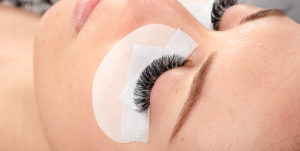Lash extensions have become a popular beauty trend, offering individuals the opportunity to enhance their natural lashes for a stunning look. However, it’s important to prioritize safety and minimize the risk of reactions or irritation during the application process. In this blog post, we will explore some common causes of allergic reactions.
Placement is Key:
The precise placement of lash extensions plays a vital role in preventing adverse reactions. Lashes should be positioned approximately 0.5 mm to 1.0 mm away from the lash line, avoiding any contact with the skin. When extensions are too close or touching the skin, it can lead to discomfort, redness, and even allergic responses.
Keeping Eyes Closed:
During the lash extension application, clients must keep their eyes closed completely. By doing so, they can prevent exposure to fumes emitted by the adhesive. Fumes can potentially cause eye irritation and discomfort. Therefore, it is crucial to communicate with your client and ensure a comfortable and safe experience by practicing proper eye closure.

Moderation in Adhesive Usage:
The amount of adhesive used during the lash application process is crucial. While it may be tempting to use excessive adhesive for a stronger bond, this can significantly increase the chances of reactions. It’s essential to follow the manufacturer’s guidelines and use an appropriate amount of adhesive to minimize the risk of irritation or allergies.
Mindful Tape Placement:
Tape is often used to secure the lower lashes during the application process, but it should be placed with care. The tape should not come too close to the sclera (the white part of the eye) to avoid any bruising or discomfort. A skilled lash technician should take necessary precautions to protect the delicate eye area during the application process.

Allergies and Sensitivities:
It’s crucial to be aware of any allergies or sensitivities you may have to specific ingredients present in the gel patches, tape, or adhesive. Before the application process, make sure to ask the client about any known allergies or sensitivities. Then ensure you use alternative products that are hypoallergenic or suitable for sensitive individuals, minimizing the risk of allergic reactions
Thorough Lash Cleaning:

Proper cleaning of the lashes is essential to prevent reactions caused by bacteria and makeup residue. Before getting lash extensions, make sure to cleanse your client’s natural lashes thoroughly and remove any traces of makeup or oil. This not only creates a clean surface for the adhesive but also reduces the risk of potential bacterial growth.
Final thoughts:
Lash extensions can provide a beautiful look, but it’s important to prioritize safety and avoid any adverse reactions. By ensuring proper lash placement, using an appropriate amount of adhesive, keeping eyes closed during the application; and practicing thorough lash cleaning, you can minimize the risk of irritation and discomfort. Additionally, communicate with your client about any known allergies or sensitivities will help create a customized and safe experience. Remember, lash extensions are not only about beauty but also about preserving the health and well-being of your eyes. Try to avoid these common causes of allergic reactions the next time you lash.
XOXO,
Bella Lash
